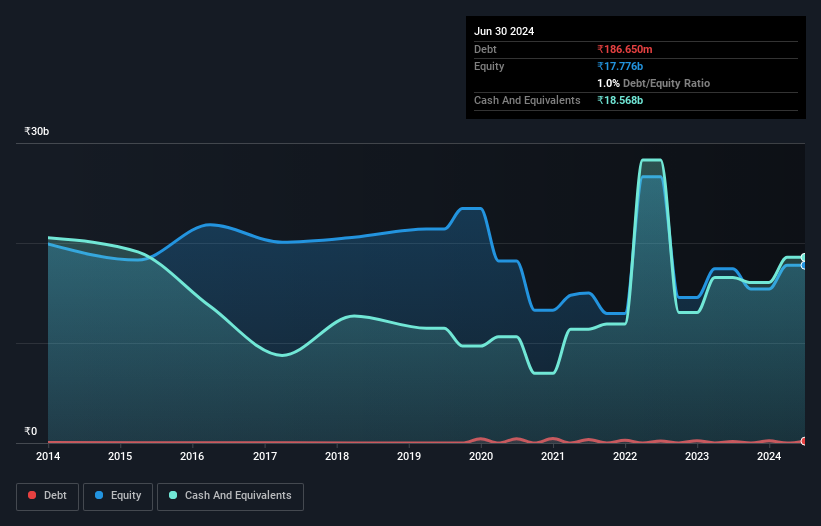We Think GlaxoSmithKline Pharmaceuticals (NSE:GLAXO) Can Manage Its Debt With Ease

Howard Marks put it nicely when he said that, rather than worrying about share price volatility, 'The possibility of permanent loss is the risk I worry about... and every practical investor I know worries about.' So it might be obvious that you need to consider debt, when you think about how risky any given stock is, because too much debt can sink a company. We can see that GlaxoSmithKline Pharmaceuticals Limited (NSE:GLAXO) does use debt in its business. But should shareholders be worried about its use of debt?
Why Does Debt Bring Risk?
Debt and other liabilities become risky for a business when it cannot easily fulfill those obligations, either with free cash flow or by raising capital at an attractive price. Ultimately, if the company can't fulfill its legal obligations to repay debt, shareholders could walk away with nothing. While that is not too common, we often do see indebted companies permanently diluting shareholders because lenders force them to raise capital at a distressed price. By replacing dilution, though, debt can be an extremely good tool for businesses that need capital to invest in growth at high rates of return. When we think about a company's use of debt, we first look at cash and debt together.
View our latest analysis for GlaxoSmithKline Pharmaceuticals
What Is GlaxoSmithKline Pharmaceuticals's Net Debt?
As you can see below, at the end of March 2024, GlaxoSmithKline Pharmaceuticals had ₹186.7m of debt, up from ₹155.4m a year ago. Click the image for more detail. However, it does have ₹18.6b in cash offsetting this, leading to net cash of ₹18.4b.

A Look At GlaxoSmithKline Pharmaceuticals' Liabilities
Zooming in on the latest balance sheet data, we can see that GlaxoSmithKline Pharmaceuticals had liabilities of ₹15.2b due within 12 months and liabilities of ₹2.54b due beyond that. Offsetting this, it had ₹18.6b in cash and ₹3.50b in receivables that were due within 12 months. So it can boast ₹4.27b more liquid assets than total liabilities.
Having regard to GlaxoSmithKline Pharmaceuticals' size, it seems that its liquid assets are well balanced with its total liabilities. So it's very unlikely that the ₹475.0b company is short on cash, but still worth keeping an eye on the balance sheet. Simply put, the fact that GlaxoSmithKline Pharmaceuticals has more cash than debt is arguably a good indication that it can manage its debt safely.
Another good sign is that GlaxoSmithKline Pharmaceuticals has been able to increase its EBIT by 25% in twelve months, making it easier to pay down debt. When analysing debt levels, the balance sheet is the obvious place to start. But it is future earnings, more than anything, that will determine GlaxoSmithKline Pharmaceuticals's ability to maintain a healthy balance sheet going forward. So if you want to see what the professionals think, you might find this free report on analyst profit forecasts to be interesting.
But our final consideration is also important, because a company cannot pay debt with paper profits; it needs cold hard cash. GlaxoSmithKline Pharmaceuticals may have net cash on the balance sheet, but it is still interesting to look at how well the business converts its earnings before interest and tax (EBIT) to free cash flow, because that will influence both its need for, and its capacity to manage debt. Over the most recent three years, GlaxoSmithKline Pharmaceuticals recorded free cash flow worth 70% of its EBIT, which is around normal, given free cash flow excludes interest and tax. This cold hard cash means it can reduce its debt when it wants to.
Summing Up
While we empathize with investors who find debt concerning, you should keep in mind that GlaxoSmithKline Pharmaceuticals has net cash of ₹18.4b, as well as more liquid assets than liabilities. And we liked the look of last year's 25% year-on-year EBIT growth. So is GlaxoSmithKline Pharmaceuticals's debt a risk? It doesn't seem so to us. The balance sheet is clearly the area to focus on when you are analysing debt. However, not all investment risk resides within the balance sheet - far from it. We've identified 1 warning sign with GlaxoSmithKline Pharmaceuticals , and understanding them should be part of your investment process.
If, after all that, you're more interested in a fast growing company with a rock-solid balance sheet, then check out our list of net cash growth stocks without delay.
If you're looking to trade GlaxoSmithKline Pharmaceuticals, open an account with the lowest-cost platform trusted by professionals, Interactive Brokers.
With clients in over 200 countries and territories, and access to 160 markets, IBKR lets you trade stocks, options, futures, forex, bonds and funds from a single integrated account.
Enjoy no hidden fees, no account minimums, and FX conversion rates as low as 0.03%, far better than what most brokers offer.
Sponsored ContentNew: Manage All Your Stock Portfolios in One Place
We've created the ultimate portfolio companion for stock investors, and it's free.
• Connect an unlimited number of Portfolios and see your total in one currency
• Be alerted to new Warning Signs or Risks via email or mobile
• Track the Fair Value of your stocks
Have feedback on this article? Concerned about the content? Get in touch with us directly. Alternatively, email editorial-team (at) simplywallst.com.
This article by Simply Wall St is general in nature. We provide commentary based on historical data and analyst forecasts only using an unbiased methodology and our articles are not intended to be financial advice. It does not constitute a recommendation to buy or sell any stock, and does not take account of your objectives, or your financial situation. We aim to bring you long-term focused analysis driven by fundamental data. Note that our analysis may not factor in the latest price-sensitive company announcements or qualitative material. Simply Wall St has no position in any stocks mentioned.
About NSEI:GLAXO
GlaxoSmithKline Pharmaceuticals
Manufactures, distributes, and trades in pharmaceuticals in India and internationally.
Outstanding track record with flawless balance sheet.


